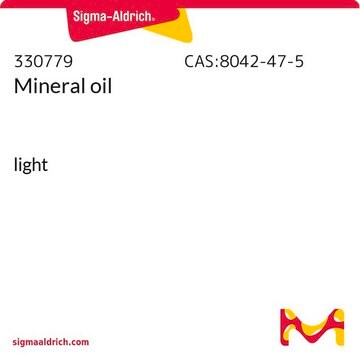18512
Paraffin oil
puriss., meets analytical specification of Ph. Eur., BP, viscous liquid
About This Item
Recommended Products
Agency
meets analytical specifications of BP
meets analytical specifications of Ph. Eur.
Quality Level
grade
puriss.
form
viscous liquid
quality
meets analytical specification of Ph. Eur., BP
technique(s)
IR spectroscopy: suitable
impurities
acidity or alkalinity, complies
aromatic polycycl. hydrocarbons, complies
residual solvents, complies
solid parafins, complies
dynamic viscosity
110-230 mPa.s
density
0.827-0.890 g/mL at 20 °C
suitability
complies for reaction against H2SO4
in accordance for identity (IR)
application(s)
metabolomics
pharmaceutical (small molecule)
vitamins, nutraceuticals, and natural products
Looking for similar products? Visit Product Comparison Guide
Application
- Polymer Physics behind the Gel-Spinning of UHMWPE Fibers: Though indirectly related, the study′s focus on material science can be paralleled with research on paraffin oil′s role in polymer processing and synthesis, especially in contexts where its lubricating properties are critical to the manufacturing processes (Wang et al., 2024).
Other Notes
The article number 18512-6X1L will be discontinued. Please order the single bottle 18512-1L which is physically identical with the same exact specifications.
Signal Word
Danger
Hazard Statements
Precautionary Statements
Hazard Classifications
Asp. Tox. 1
Storage Class Code
10 - Combustible liquids
WGK
WGK 2
Flash Point(F)
419.0 °F - closed cup
Flash Point(C)
215 °C - closed cup
Personal Protective Equipment
Choose from one of the most recent versions:
Already Own This Product?
Find documentation for the products that you have recently purchased in the Document Library.
Customers Also Viewed
Our team of scientists has experience in all areas of research including Life Science, Material Science, Chemical Synthesis, Chromatography, Analytical and many others.
Contact Technical Service










